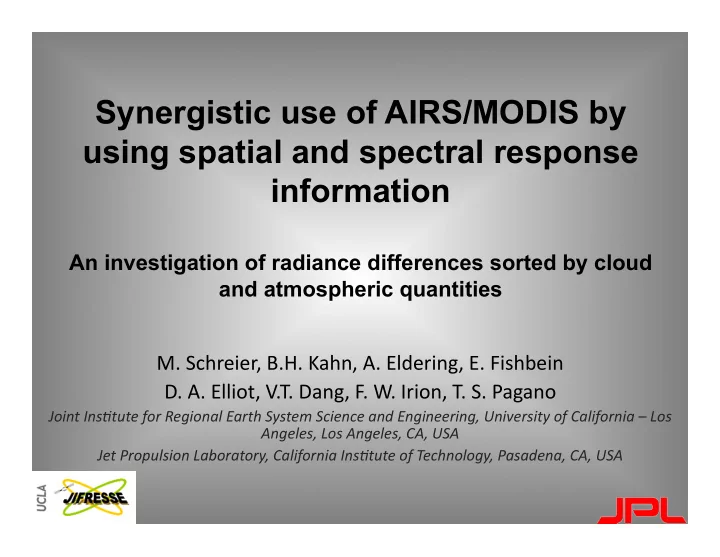

Synergistic use of AIRS/MODIS by using spatial and spectral response information An investigation of radiance differences sorted by cloud and atmospheric quantities M. Schreier, B.H. Kahn, A. Eldering, E. Fishbein D. A. Elliot, V.T. Dang, F. W. Irion, T. S. Pagano Joint Ins)tute for Regional Earth System Science and Engineering, University of California – Los Angeles, Los Angeles, CA, USA Jet Propulsion Laboratory, California Ins)tute of Technology, Pasadena, CA, USA
Overview • Why combine AIRS and MODIS ? • How to combine ? • Comparison with spaIal and spectral informaIon • Comparison with Level 2 ‐ Data • Conclusion
Why combine? SpecificaIons of the instruments AIRS : MODIS : ‐ Located on Aqua ‐ Located on Aqua (and Terra) ‐ Scan width of 1650 km (90 scans) ‐ Scan width of 2330 km (1354 scans) ‐ High Spectral ResoluIon in IR (2378 ‐ 36 Broadband‐Channels between channels from 3.7 – 15.4 µm) (0.4‐14 µm) ‐ includes absorpIon lines of CO 2 , ‐ includes channels for CO 2 ‐slicing H 2 O, O 3 ,… ‐ includes 1.38 µm for Ci‐detecIon ‐ Field of View is approx 1.1 ° ‐ Field of View is approx 0.08 ° (1 km at (13.5 km at NADIR) NADIR) ‐ Collocated with AMSU (Microwave) ‐ A lot of Level 2‐ products available
Why combine? A lot of MODIS‐channels overlap with AIRS in the Infrared Black line: AIRS MODIS : Response curves: MODIS
Why combine? SensiIvity of the channels in IR AIRS‐Channels for cloud clearing MODIS Channels for CO 2 ‐Slicing AIRS has more channels and therefore beder sensiIvity of cloud top height – But worse spaIal resoluIon hdp://www.ssec.wisc.edu/~baum/CloudPressure/CloudPressure.html
Why combine? Comparison of “stand alone products” retrieved cloud properIes Cloud Top Temperature EffecIve Cloud FracIon MODIS AIRS
How to combine? Comparison of one scene MODIS AIRS 2030 pixel 135 pixel 1354 pixel 90 pixel
How to (beder) combine? The crux ‐ or advantage ‐ of spaIal response of AIRS Within one AIRS Channel are several MODIS Channel measurements, which 1 have to be weighted according to the MODIS spectral response there exist pre‐launch‐ Channel measurements 2265 ROUND TRUNCATED ROTATED SMEARED pre‐launch Include blinds Dependence on Take into measured scan angle account moving
How to combine? The crux ‐ or advantage ‐ of spectral response of MODIS Within one MODIS Channel are several AIRS Channels which have to be weighted according to the MODIS spectral response there exist pre‐launch‐ measurements
How to combine? The spectral shij by Tobin et al., 2006 Example: Channel 36 Shift by 5 cm -1 Tobin et al, 2006 proposed the shift of the MODIS response response functions for several channels
Comparison Comparison of Radiances/Temperatures The main “problemaIc areas” are cloud edges. The use of accurate spaIal and spectral response helps to reduce the variaIon
Comparison Channels and Scan‐Angle So, the variance is reduced …. … the scan angle dependence is reduced …. … but there are sIll strange features.
Including Level 2 Data Use of MODIS L2‐data to look onto cloud coverage within AIRS We can beder calculate the average amount of Clouds, Cirrus, Aerosol, surface, … within a “big” AIRS‐ footprint, by using MODIS Grey area: Use of MODIS L2 e.g. Ice cloud‐flag or thin Cirrus‐Flag (1.38 µ m)
Including Level 2 Data Is there a correlaIon of cloud coverage and ΔBT ? The variaIon of ΔBT is reduced by using spaIal and spectral response funcIons and shows strong correlaIon to most cloud types or aerosol But: there is an interesIng correlaIon to ice clouds outside of the window‐channels
Including Level 2 Data Is there a correlaIon of cloud coverage and ΔBT AND AIRS Level 2 ‐ product ? Increasing lapse rate dT/dp
Including Level 2 Data Is there a correlaIon of cloud coverage and ΔBT AND AIRS Level 2 ‐ product ? Increasing water vapor
Including Level 2 Data Is there a correlaIon of cloud coverage and ΔBT AND AIRS Level 2 ‐ product ? The use of the spectral shift for channels 27, 28, 35 and 36 removes the correlation
Conclusion MODIS and AIRS provide the possibility to combine highly accurate spaIal • and spectral resoluIon Using spectral and spaIal response funcIons (also depending on scan • angle) helps to reduce variaIons of ΔBT The behavior of ΔBT for different cloud‐types can be analyzed by using the • spaIal response of AIRS in combinaIon with cloud properIes from MODIS There are correlaIons of ice cloud coverage and ΔBT, which are also • influenced by temperature gradient and water vapor, if no spectral shij of MODIS is included The spectral shij of MODIS is an is an important factor for the • combinaIon of the instruments
Thank you !
How to (beder) combine Dependence on Viewing angle Put the center of the footprint over the nearest point and weight the MODIS‐pixel according to the spaIal response funcIon of AIRS and the spectral response of the MODIS‐channel AIRS‐footprints MODIS‐grid
Recommend
More recommend